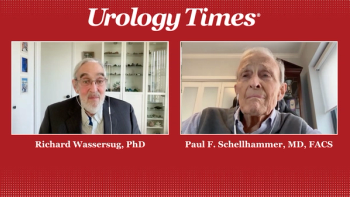
Dr. Tran on enzalutamide plus salvage radiation therapy in biochemically recurrent prostate cancer
The phase 2 SALV-ENZA trial explored whether the addition of enzalutamide to salvage radiation therapy could improve outcomes in patients with high-risk, PSA-recurrent prostate cancer after radical prostatectomy.
Phuoc T. Tran, MD, PhD, professor radiation oncology, vice chair of research, University of Maryland School of Medicine, discusses outcomes from the phase 2 randomized SALV-ENZA trial, which discussed salvage radiation therapy plus enzalutamide (Xtandi) or placebo in patients with high-risk PSA-recurrent prostate cancer after radical prostatectomy.
Video Transcript
The SALV-ENZA trial was a phase 2, randomized, placebo-controlled, double-blinded study looking at men who have relatively high-risk, biochemically recurrent prostate cancer. All patients had to have a rising PSA after radical prostatectomy, they can be Gleason 8 to 10, or were also eligible if they had a Gleason 7 and either what we call pathologic T3 or margin-positive disease. PSA had to be less than 0.7 but detectable on ultrasensitive PSA. They also had to be eugonadal which we defined as 150 or greater nanograms per deciliter in their testosterone.
Our original design was 96 patients randomized to 48 in each arm. Salvage plus placebo was the control arm and then salvage radiation plus enzalutamide was the experimental arm. Patients were stratified by a number of factors, including surgical margin status, whether they had Gleason 7 vs 8 through 10, and then study enrollment PSA.
Ultimately, we could only enroll 43 per arm, so 86 total, and the primary end point was freedom from PSA progression, which we defined as patients who were able to achieve an undetectable PSA. If their PSA reached 0.2 or greater, that was considered a PSA progression event or if they were not able to achieve undetectable PSA following their treatment phase, progression was determined to be a rise of 0.2 above their nadir.
This was a well-balanced trial; modern day enrollment of patients, so pre-salvage radiation PSA was 0.3, which is very consistent with patients we enroll nowadays. Again, very well balanced and the primary endpoint of the trial was positive for freedom from PSA progression with a hazard ratio of 0.42 that was statistically significant, and at 2 years, approximately a 20% improvement in enzalutamide-containing arm. Pre-specified subset analysis suggested that patients with T3 or margin-positive disease may benefit more from the addition of enzalutamide as compared to placebo.
The transcript has been edited for clarity.
Newsletter
Stay current with the latest urology news and practice-changing insights — sign up now for the essential updates every urologist needs.




















